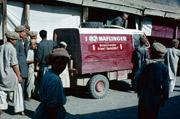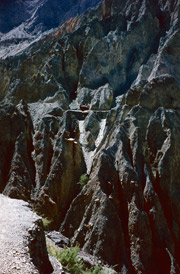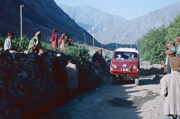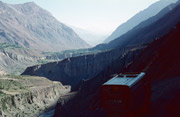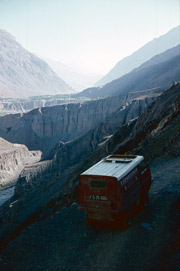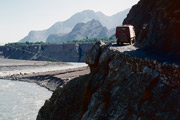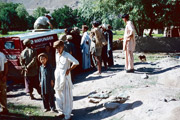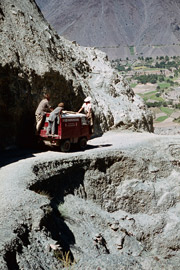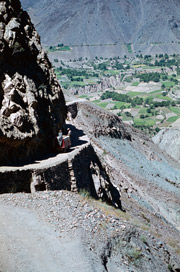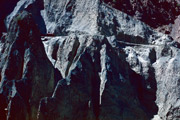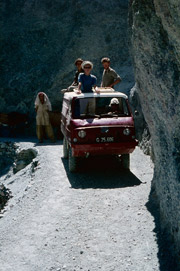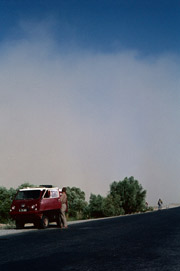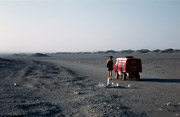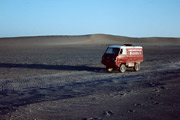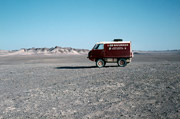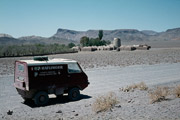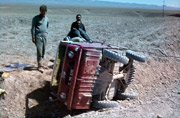 |
|||||||||||||||||
 |
|||||||||||||||||
 |
|||||||||||||||||
 |
|||||||||||||||||
|
|||||||||||||||||
|
Karakorum-Himalaya 1964At the beginning, I'd like to thank Prof. Dr. Rudolf Pischinger for his help. Willingly, he supplied me with information and looked up all Haflinger pictures from his huge slide collection when I approached him with my request to find out more about the "Steirische Karakorum-Himalaya Expedition 1964" (in english: Styrian Karakorum-Himalaya Expedition 1964). Zu Beginn möchte ich mich sehr herzlich bei Prof. Dr. Rudolf Pischinger für seine Hilfe bedanken. Auf meine Recherche-Anfrage hin versorgte er mich bereitwillig mit Informationen zur "Steirischen Karakorum-Himalaya Expedition 1964" und durchforstete seine große Dia-Sammlung, um jene Bilder auszugraben, auf denen der damals verwendete Haflinger zu sehen ist. I would like to sum up the information I received from Dr. Pischinger and describe the expedition in some words: A group of five enthousiastic mountaineers left Graz in early April 1964. Four of them embarked the ship "Asia" at Genova together together with a Haflinger that was provided by Steyr-Puch for the journey. According to information from Dr. Pischinger, it is very likely that this was the same vehicle which was used by Mathias Rebitsch and Luis Vigl for the Atacama-Expedition in 1961. Via Aden, Jemen, the ship finally arrived at Karachi in Pakistan, where the group was received by a liaison-officer. Together with this officer, Dr. Rudolf Pischinger drove the Haflinger all the way up north to Lahore and finally to Rawalpindi, where all mountaineers stayed with a former officer from Great Britain. Eine kleine Zusammenfassung der Expedition anhand der Informationen von Dr. Pischinger: Fünf begeisterte Bergsteiger starteten von Graz aus im April 1964. Vier von ihnen, darunter Dr. Pischinger, reisten via Schiff von Genova aus über Aden (Jemen) nach Karachi in Pakistan. Ebenfalls an Bord war ein Haflinger als Begleitfahrzeug für die Expedition. Es dürfte sich dabei um dasselbe Fahrzeug handeln, das schon Mathias Rebitsch und Luis Vigl 1961 für die Atacama-Expedition benutzten. In Pakistan wurde die Gruppe von einem Verbindungsoffizier empfangen, der anschließend mit Dr. Pischinger im Haflinger nach Lahore und weiter nach Rawalpindi reiste, wo alle Bergsteiger bei einem ehemaligen Britischen Offizier residierten. On the way to Lahore, the liaison-officer also wanted to get behind the steering wheel of the Haflinger - Dr. Pischinger agreed and let him drive. At that time, only a small strip in the middle of the road was sealed, so if opposing traffic came along, one vehicle had to hop off the road into the dust. Of course, a true Pakistani driver would not wimp out until the last second! So when a big truck came along, it was just in the very last moment that the liaison-officer changed the course to avoid a crash. However, one of the small Haflinger wheels got caught in the dirt and the Haflinger landed on its right side in the middle of the road. The right window was open and Dr. Pischinger was hurt on his arm. The metal roof was bent and the Haflinger had to be towed to the next village to be repaired. None the less, Dr. Pischinger could continue his ride northwards lateron. Auf dem Weg nach Lahore wollte auch der Verbindungsoffizier hinter das Steuer des Haflingers, was ihm Dr. Pischinger gestattete. Damals war nur ein einspuriger Streifen in der Mitte der Fahrbahn asphaltiert, weshalb man bei Gegenverkehr von der befestigten Fahrbahn in den Staub ausweichen musste - "Wer kneift zu letzt"-Bewerbe standen an der Tagesordnung! Bei einer Begegnung mit einem LKW riss der Pakistanische Verbindungsoffizier erst in letzter Sekunde das Lenkrad herum. Eines der Räder des Haflingers verfing sich daraufhin im losen Teil der Fahrbahn und der Haflinger landete auf der seiner rechten Seite, mitten auf der Straße. Das rechte Fenster des Führerhauses war offen und Dr. Pischinger erlitt Aufschürfungen am Arm. Auch der Aufbau des Haflingers wurde beschädigt und so musste das Fahrzeug zur Reparatur zum nächsten Ort geschleppt werden. Später konnte Dr. Pischinger die Fahrt richtung Norden fortsetzen. The first goal of the expedition was to climb the "Momhil Sar". Therefore, the group traveled to Gilgit by plane, and Jeeps were then used to reach the small village Nagar via an adventurous road. From there, the group had to walk. The peak of Momhil Sar could finally be climbed on 29th of July after two failed attempts! Since then, the Momhil Sar was not climbed again. In early August, Dr. Pischinger returned to Rawalpindi and a slightly different group continued with the next targets of the expedition. The Haflinger was in action again and driven to Chitral, where the following photo series starts. All pictures shown on this page were taken by Dr. Pischinger and they are published with his permission.
Das erste Ziel der Expedition war die Besteigung des "Momhil Sar". Dazu reiste die Gruppe mit dem Flugzeug nach Gilgit und von dort mit Jeeps über eine abenteuerliche Strecke weiter nach Nagar. Von
Nagar aus ging es nur noch zu Fuß weiter. Den Gipfel des Momhil Sar erreichten die Bergsteiger nach zwei gescheiterten Versuchen schließlich am 29. Juli! Seither wurde der Berg nie mehr bestiegen. Im August
kehrte Dr. Pischinger nach Rawalpindi zurück und setzte von dort die Expedition (mit einer etwas veränderten Gruppe) fort. Der Haflinger war wieder im Einsatz um nach Chitral zu fahren. Dort beginnt auch die
folgende Fotoserie. Die Bilder wurden von Dr. Pischinger aufgenommen und sind hier mit seiner Erlaubnis veröffentlicht. Northern PakistanTravelling home through IranLinks
CommentsHere is, where your part of the page begins! If you have anything to contribute, feel free to add a comment! At the moment, there exists 1 comment for this page.
|
||||||||||||||||
|
|||||||||||||||||
 |
|||||||||||||||||






